2024
Atargatis’s Siren
My work examines the intersections of Media Studies, Archaeology, and media archaeology (alternative or “unexcavated” media histories). In “Atargatis’s Siren,” the Eastern Mediterranean Sea itself serves as media, delivering information about climate change via warming regional water temperatures, the consequential inundation of invasive tropical species, and rising sea levels.
I superimposed AI generated mermaids (because mermaids do not literally exist to document) onto photographs that I took in the Harbor of Rhodes. I interspersed these still images with videos and audio (both terrestrial and underwater) that I captured along the coast of Rhodes. The mermaids also become media agents – dire signals (sirens) trying to get humans’ attention.
I view these mermaids as messengers or priestesses of Atargatis, a Bronze Age Semitic fish-tailed goddess. Worshiped in the region known in antiquity as Syro-Palestine, Atargatis represented love, the sea, “feminine powers,” protection of both cities and people…and mourning. Archaeologists have found evidence of her veneration in Ashkelon (today part of Israel), Hierapolis (today part of Syria), and north of Petra (in today’s Jordan); but the popularity of mermaids eventually spread through the Mediterranean.
Here and now, the mermaids’ urgent message is, “We have seen rising sea levels and climate crises in the Eastern Mediterranean during the Bronze Age, and it did not bode well for civilizations.”
Atargatis’s mermaids encourage us to learn from the past. The mermaids also remind us that there is a mutual, overarching threat to all of the coastal modern geopolitical entities that once comprised Syro-Palestine–Syria, Lebanon, Palestine, Israel–as well as to Greece, Turkey, and Cyprus. The mermaids offer a feminist alternative to warring with one another, which is pulling together to heal and protect that which sustains all life–the sea. The sea connects us.
These media assets are part of storyboarding and pre-visualization for a multiplayer VR game about healing the Eastern Mediterranean Sea called “Atargatis’s Allies.” The concept for both the video and the game is inspired by the Arava Institute for Environmental Studies in Eilat, Israel. Recently nominated for a Nobel Peace Prize, the school brings together Palestinian, Jordanian, and Israeli students to solve environmental problems in the Levant. Arava’s moto is “The environment knows no borders.”

2018
Mapping Hathor Through Timna
(A mapped collection of research media sketches in Google Earth: sound, photographs, and 360 video: PLEASE NOTE: Only Chrome and Firefox browsers support viewing 360-video as such. )
In the summer of 2017, I took my first trip to Timna Park in the Negev, Israel. At Timna, ancient Egyptians mined copper during the reign of five pharoahs, starting with Seti I (reigned 1290-1279 b.c.e). The laborers esteemed the goddess Hathor because they believed that, in her guise as Goddess of the Mountain, she offered her protection. However, Hathor is more commonly known as a goddess of music, motherhood, sensuality, sexuality, and beer. She was a good-time goddess, as the Egyptians believed in pleasure and happiness as forms of worship. If you were not happy, it showed dissatisfaction with what the deities were providing for you. At Timna, I captured photographs, video, and 360 video to try to get closer to this history. I also experimented with capturing audio at archaeology sites using a sistrum, a percussion instrument sacred to the priestesses and musicians of Hathor. I was interested in two primary questions about Timna: 1) What was the role of women at the mining camps? 2) Can we learn anything about Timna sites, or how people used them, by paying attention to acoustics?
https://earth.google.com/earth/d/1jYpjkNpzFza4VU_ojJ1LWN2tk7WE1Csn?usp=sharing

2017
Slice of Wadi Rum (360-degree video)
PLEASE NOTE: Only Chrome and Firefox browsers support viewing 360-video as such.
A 360-degree video for use in a VR headset. Shot in Wadi Rum, Jordan, this video is part of an Arabic language learning game for finding nouns, verbs, and adjectives. See the VR/AR/Games page of this site for game instructions.
(Note only Firefox and Chrome support 360-video.)

Hear Me Now
“Hear Me Now” makes audible the spirits of sistrum rattling musicians of Hathor who inhabited the ancient Egyptian copper mining valley of Timna about 3200 years ago. Hathor was commonly known as a goddess of music, motherhood, sexuality, and sensuality; but in her Goddess of the Mountain guise, she was also the patron goddess of the Timna miners who sought her protection in the Negev.
Please respect that this video contains ancient human remains. (As per IAA ethics recommendations, this video was password protected until these sensitive archaeological finds were published.)

She Studies Seashells: a field interview with Dr. Beverly Goodman
Dr. Beverly Goodman, professor at University of Haifa, talks about her marine geophysical archaeology research at Caesarea. She explains and how seashells can help to date ancient tsunamis, and how a story in the [Old Testament] Talmud might provide researchers with some clues about a particular tsunami.
In 2020, excerpts from this video were used by Caesarea television channel 98 in Israel for a documentary they produced about Dr. Goodman’s work.

IUI Research Vessel Algae Tests at 40 Meters (360-degree video)
(Only Chrome and Firefox browsers support viewing 360-video as such.)
Research experiment footage shot in 360 in the Red Sea for The Interuniversity Institute of Marine Sciences in Eilat, Israel. While intended as an experiment to test the depths limit of my 360-Fly camera, this long take shot turned out to be actually artistically interesting! –especially the sound.
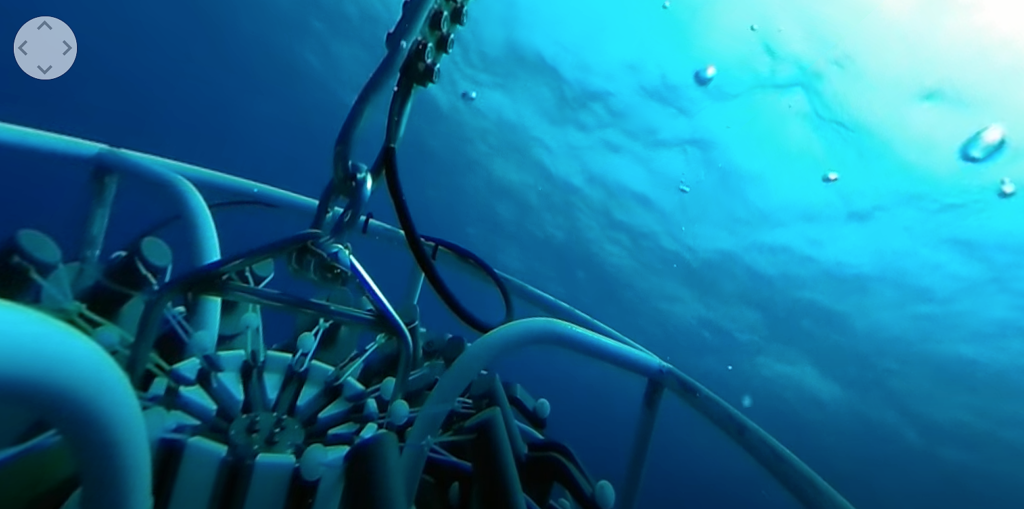
2015
Hieros Gamos
A short film about desire, loss, fertility and parthenogenic goddesses. Filmed in residence at Skopelos Foundation for the Arts in Greece, I presented this piece as a video installation at an art show on the island.

2010
The Frog and the Scorpion, An Eritrean Children’s Story from Bilen
I created this video version of a classic fable for the Center for African Studies at University of California at Berkeley. It is in four versions:
English with English subtitles
English with Tagrignya subtitles
Tagrignya with English subtitles
Tagrignya with Tagrignya subtitles
Click any of the four to see that version on YouTube.
Special thanks to Solomon Tsehaye and Issayas Tesfamarian for their translation work and Yonas Ghirmay for use of his music.


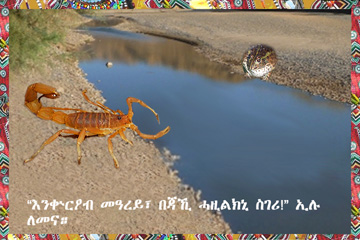



2008
Ghosts of Seneca Falls
This site-specific three-projector video installation was shown at the Women’s Rights National Historic Park in upstate New York over Labor Day Weekend, 2008. It sought to animate the “ghosts” of an event that took place in the Wesleyan Chapel in 1848–the reading of the Declaration of Sentiments in 1848. That is the platform from which Elizabeth Cady Stanton and her peers demanded several new equity rights for women, such as the right of women to keep their own wages and property when they married. Most radical was their demand for women to have the right to vote. The fight for suffrage in the United States began on this evening and waged for seventy years.
The soundtrack for this piece asks San Francisco Bay Area residents historical questions about this East Coast historical event and related events, such as: “When did the women’s movement begin in America?” “Who is Sojourner Truth?” “What amendment gave women the right to vote?” and “What is Title 9?” It also asks opinion-driven questions such as: “What IS ‘post-feminism’?” and “What is left for the Fourth Wave to tackle for gender equity?” Voices are laid over ambient sounds from San Francisco such as cable cars and waves at the shore.
The site documenting this piece, www.pelefire/com/senecafalls, includes video excerpts of the installation in situ, sound clips for use in classrooms, and resources for voting.


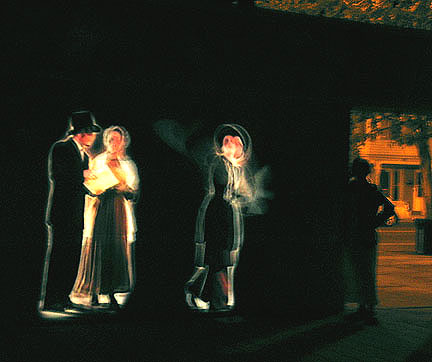
2005
Luxor-Qurna Diaries
I went to Egypt seeking the pharaoh Hatshepsut. I thought I was failing, until I realized that I was looking for an ancient Hillary Clinton when I probably should have been looking for a character more like Hatshepsut’s patron goddess of love, play, sensuality, music, and mothering, Hathor. Then I began to see Hatshepsut all around me, in the people of Luxor. This is a three-projector video installation with spatialized sound. I projected onto materials representative of Luxor.



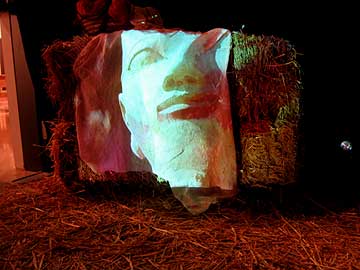


2003
Patricia Silver’s Stories
– is a video installation that explores the memories of an eighty-year-old San Francisco woman who had many harrowing experiences during the McCarthy Era.
The stories were divided into three parts. In “The Story of Westover Field,” Silver recalls her detention at Westover Field air base. En route to Germany to help with reconstruction efforts, she was held for several weeks without explanation or representation. “Patricia Silver on Her Father, McCarthy, and Hollywood Communism” recounts Silver’s reoccurring trials with federal agents as she tried to hide her father and friends. Her father, Val Burton, was a blacklisted screenwriter and a self-professed member of the Communist Party. (Silver herself did not share his political affiliations.) Her friends included Haakon and Barbara Chevalier of the infamous “Chevalier Incident.” (This scandal broke when Robert Oppenheimer, of the Manhattan Project, was manipulated into naming members of the Berkeley leftist circles in which he once swirled, including names of his longtime friends. Chevalier was, consequently, falsely accused of being a communist spy.) In part three, Silver stresses the importance of dissent and speaking truth to power as a fundamental tenant of Americanism. She points out the media censorship of the Dixie Chicks and Michael Moore during the Iraq War evoked McCarthyism.
See an excerpt at http://www.youtube.com/watch?v=OIqF-Q5uchg&feature=mfu_in_order&list=UL.



2002
Califor-ni-a HO!
(No YouTube link–stills only.)
Californ-i-a Ho! Shines the spotlight on 4 amazing women from the California Gold Rush era. Jenny Wimmer figured out that the nugget found at Sutter’s Mill was indeed gold. Helen Carpenter left a rich, imagistic diary of her overland journey from New England to Grass Valley, California. Lola Montez was a wild free spirit who left quite a legacy in the neighboring Sierra Foothill town of Nevada City. Mary Ballou was an African American woman asserting her independence by homesteading on her own.
Running time 12 minutes.





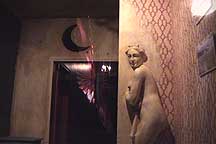
Sample Video

Ambition: “Best Worldbuilding”


Ambition: “Best Immersive Media”


Ambition: “Best Sound Design”

